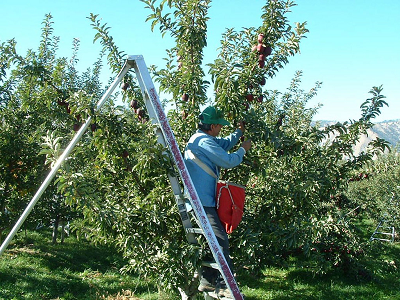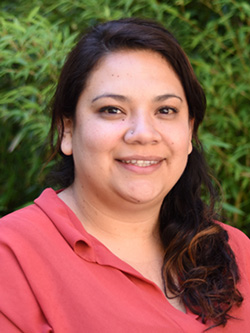In the Pacific Northwest, cherries, peaches, plums and many other fruits mean summer — thanks to the people who harvest them. As climate change makes our region’s summers increasingly hot and smoky, researchers and policymakers are becoming more concerned about the health impacts on these agricultural workers.
“Agriculture workers, especially crop and tree fruit workers, often must work outside regardless of temperature or air quality,” said John Flunker, a postdoctoral researcher in the UW Department of Environmental & Occupational Health Sciences (DEOHS). “Harvesting duties frequently coincide with extreme heat or wildfire smoke. So, they're really on the frontlines of exposure.”
In the past two years, the Washington State Department of Labor & Industries (L&I) implemented new permanent rules designed to protect outdoor workers from health impacts related to heat and wildfire smoke.
In August, a team led by Flunker and Dr. Coralynn Sack, an assistant professor in DEOHS and the UW Department of Medicine, headed out to several apple farms in Washington’s Yakima Valley to get a clearer picture of how these stressors affect crop workers’ health and how the new rules are being implemented in the field. Yakima County has the largest number of crop workers of any county in the state.
Researchers know that both heat and wildfire smoke adversely affect health, “but we have a dearth of data in the people who are most vulnerable and highly exposed,” Sack said. “Agricultural workers are working long hours with increased metabolic rate, meaning they may have an increased internalized dose of pollutants, with few options for protection.”

Health impacts of heat, smoke and both at once
Heat exposure can cause dehydration, fatigue and confusion — symptoms of heat-related illness. When it’s severe, heat exposure can cause heat stroke, which can lead to death.

“Humans try to keep their bodies in a pretty narrow temperature range,” said Research Associate Professor Dr. June Spector, who is also the Occupational Disease lead at the L&I Safety & Health Assessment & Research for Prevention (SHARP) Program.
Spector and other DEOHS faculty and alumni offered technical expertise and comments during the heat and smoke rulemaking processes.
It’s important to think about more than the air temperature when spending time outside, Spector said. “You actually generate heat when you work, too. If you’re wearing nonbreathable clothing, that can also add to this net heat load or heat stress.”
Our bodies cool down through sweating, a process that makes the cardiovascular system work harder and works best when hydrated, she added.
Some acute effects of wildfire smoke include itching or irritated eyes, a stuffy nose, and a cough or scratchy throat. More serious effects include shortness of breath, heart palpitations and difficulty breathing.
“There's some evidence that coexposures (to both heat and wildfire smoke) may compound the health effects for each exposure alone, and may increase the risk for developing adverse outcomes,” Sack said.
Researchers think that’s because heat can compound some of the effects of air pollution, inducing oxidative stress and both pulmonary and systemic inflammation.
Into the orchards

This summer and fall, Flunker, Sack and their team are following 35 apple pickers who volunteered for their study at three farms near Naches and Tieton. The study is funded by the UW Population Health Initiative and the Firland Foundation.
In addition to collecting surveys from the workers on symptoms of illness related to heat and wildfire smoke, Sack will measure their respiratory health on at least four days chosen based on thresholds that are part of the new rules: 90° F and an air quality index of 100. They will examine workers when temperature and air quality are both below these thresholds; times when each individual limit is exceeded, and a time when both of them are exceeded.
According to the new Washington state rules, for example, when temperatures are 90° F or greater, outdoor workers must take a mandatory cool-down rest break for 10 minutes every two hours. At an air quality index of 100, employers must offer workers respirators, and at higher levels of particulate matter more protective measures are required.

Sack will measure lung function and airway inflammation in participants using a spirometer and a device that detects exhaled nitric oxide. These parameters will help provide objective measurements of lung health and determine whether participants are experiencing acute effects related to heat and wildfire smoke exposure.
The researchers will monitor how many days workers are exposed to high heat, poor air quality, and coexposures to both; and how often workers use respirators and other safety practices. They will also call to survey them after major heat or wildfire smoke events.
Even when wildfire smoke blankets the area, crop workers oftentimes don’t wear respirators, Flunker said.
“It's hard, demanding physical labor, which is not easy to accomplish while wearing a respirator,” he said.
There is also a tradeoff between the protection respirators offer and the thermal discomfort they can cause, Sack added.
Fostering community connections and worker protection

Pablo Palmández, a member of the research team and agricultural research and safety extensionist at the Pacific Northwest Agricultural Safety and Health (PNASH) Center, part of DEOHS, drew on existing relationships with apple growers to facilitate the study.
“It’s so important, having community-level ties and ensuring that there's good communication, and also that the study benefits the workers directly,” Sack said.
To that end, the team is developing a training module for reducing the impacts of heat and wildfire smoke to share with workers participating in the study, and will also share results of the project with workers. For workers with abnormal results, Sack will call to provide medical counseling and help facilitate their medical care if needed.
Separately, DEOHS Clinical Assistant Professor Maria Blancas and the PNASH Center’s outreach team recently updated its HEAT toolkit for agricultural workplaces, which has won awards from the EPA and OSHA. It now includes a new acclimatization module, poster and best practices guidance.
PNASH has also partnered with Washington State University’s AgWeatherNet program on a heat alert system that workers and growers can sign up for to receive free, near-real-time information on the risk of heat stress.

Acclimatization: A big word emphasizing baby steps
One practical solution we can all be aware of now is acclimatization. According to Spector, our bodies take between seven days and two weeks to adapt to working in the heat. Within the first four to five days, we begin to sweat more efficiently and effects on our cardiovascular system ease.
It is just as important for someone who is new on the job as it is for someone returning from vacation to properly acclimatize to working in the heat. The need to acclimatize also comes into play at the beginning of a heat wave.
“To the extent you can, gradually increase the amount of work in the heat each day,” Spector said. “If you can safely work in the cooler parts of the morning, and avoid that peak sun period, especially when performing heavier tasks, that's helpful.”
In an industry like agriculture where employees are often paid by the piece or amount picked, workers may be motivated to work through breaks and symptoms of heat illness.
To prevent overheating, it’s important to consider taking paid preventive breaks in the shade to rest, hydrate and cool down — and encourage peers to do so. Other helpful strategies include shifting to lighter work tasks or tasks in a cooler environment as it gets hotter.
Where should workers seek shade?

In August 2022, Flunker and a research team went out to cherry and grape fields in Prosser, Washington to study the impact of shade on workers’ heat exposure.

As daily highs broke 100° F, he and his team measured the wet bulb globe temperature, the gold standard for estimating physiological heat exposure, under a variety of conditions.
“It gave me an immense amount of respect for workers, the conditions under which they work, and the importance of acclimatization,” he said.
The researchers measured temperature in conditions of no shade, shade under the cherry trees and grape vines, and shade under pop-up canopies. To their surprise, shade structures reduced ambient temperatures but the crops they studied did not.
Although the Washington state heat rule requires employers to provide shade for breaks, it does not specify the source of shade, or how much that source should lower the ambient temperature.
“Future work is necessary to assess how well various store-bought and grower-engineered shade structures reduce heat exposure,” Flunker said. “Growers are very resourceful, so their practical solutions for providing workers with shade are likely to inform best practices and, ultimately, policy.”
From research to rule making
The researchers hope their results will not only benefit agricultural workers, but also help clarify the impact of acute and cumulative exposures to heat and smoke for members of the public, both in agricultural communities like the Yakima Valley and beyond.

The next natural step is to contribute research findings and technical expertise to action and policymaking. Spector offered her expertise leading up to a federal rule recently proposed by the U.S. Occupational Safety and Health Administration (OSHA) to protect indoor and outdoor workers from extreme heat, which is open for public comment.
More locally, she is part of the Bree Collaborative Workgroup on Health Impacts of Extreme Heat and Wildfire Smoke, an effort by the Foundation for Healthcare Quality to bring together public and private voices in healthcare related to these issues.
Sack chairs a workshop for the American Thoracic Society focused on the risks of occupational exposure to ambient air pollution: in addition to wildfire smoke, dust, diesel exhaust and other sources can threaten workers’ health. The workshop includes researchers from the UW and elsewhere, and collaborators from the National Institute for Occupational Safety and Health, Cal/OSHA and L&I.
The group plans to share a report later this year evaluating options for federal regulatory air pollution standards, with a focus on vulnerable workers, particularly agricultural workers.
“We know that these exposures are bad for people and bad for workers — in particular, those who are exposed to higher concentrations of air pollution and for longer durations,” Sack said. “There's a need for action.”




